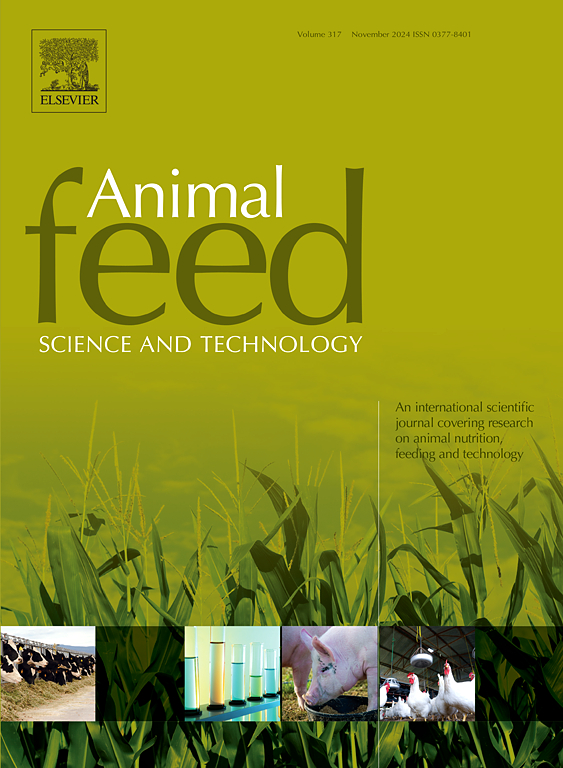日粮单日分布和多日分布对育肥利木赞公牛生长性能、行为和瘤胃健康的影响
IF 2.5
2区 农林科学
Q1 AGRICULTURE, DAIRY & ANIMAL SCIENCE
引用次数: 0
摘要
本研究比较了增肥日粮单次和多次分配对利木赞公牛生长性能、行为和瘤胃健康的影响。试验期27个月,陆续有37批利木赞公牛进入试验,完成育肥。每批被分成两组均衡的动物,然后转移到两个相同的育肥仓。一个牛棚的公牛按常规饲喂单一日分配的全混合日粮(TMR)。在第二个牛棚中,自动喂食系统(AFS)根据公牛的自愿进食情况,自行准备了类似的TMR,每天提供的次数更多。CFS组育肥701头,AFS组育肥739头,平均育肥天数分别为129天和130天(P = 0.81)。AFS平均每日排出TMR次数为4.2次 ± 1.6次。行为观察证实,公牛根据TMR给药时间调整了进食和休息活动。与CFS公牛相比,AFS每次交付时提供的鲜制日粮增加了公牛的干物质采食量(8.50 vs. 7.95 kg/d; = 0.001页)。两种饲喂方式的公牛日增重相似(1.55 vs 1.58 kg;P = 0.23)和胴体重。然而,从动物健康和福利的角度来看,与CFS相比,AFS的治疗次数更少,瘤胃黏膜疾病的发生率更低,这应该鼓励引入自动化解决方案,以增加每日饲料分配的频率。本文章由计算机程序翻译,如有差异,请以英文原文为准。
Comparison between single and multiple daily distributions of the diet on growth performance, behaviour, and rumen health of fattening Limousin bulls
The study compared the effects of single vs. multiple daily distributions of the fattening diet on Limousin bulls' growth performance, behaviour, and rumen health. The experimental period spanned 27 months, during which 37 batches of Limousin bulls progressively entered the study to complete their fattening. Each batch was split into two balanced groups of animals that were then transferred to two identical fattening barns. Bulls in one barn were conventionally fed a total mixed ration (TMR) with a single daily distribution (CFS). An automatic feeding system (AFS), operating in the second barn, self-prepared a similar TMR delivered more times a day according to bulls’ voluntary intake. A total of 701 bulls were fattened with CFS, and 739 bulls with AFS, for an average number of 129 vs. 130 days (P = 0.81), respectively. The average number of TMR daily discharges by AFS was 4.2 ± 1.6. Behavioural observations confirmed that bulls adapted their feeding and resting activities in response to the time of TMR administration. The fresh-made ration provided at each delivery by AFS increased bulls' dry matter intake compared to CFS bulls (8.50 vs. 7.95 kg/d; P = 0.001). Bulls of both feeding systems had a similar daily gain (1.55 vs. 1.58 kg; P = 0.23) and carcass weight. However, from an animal health and welfare perspective, the fewer medical treatments and the lower incidence of rumen mucosa disorders observed with AFS compared to CFS should encourage the introduction of automated solutions to increase the frequency of daily feed distributions.
求助全文
通过发布文献求助,成功后即可免费获取论文全文。
去求助
来源期刊

Animal Feed Science and Technology
农林科学-奶制品与动物科学
CiteScore
6.00
自引率
6.20%
发文量
266
审稿时长
3 months
期刊介绍:
Animal Feed Science and Technology is a unique journal publishing scientific papers of international interest focusing on animal feeds and their feeding.
Papers describing research on feed for ruminants and non-ruminants, including poultry, horses, companion animals and aquatic animals, are welcome.
The journal covers the following areas:
Nutritive value of feeds (e.g., assessment, improvement)
Methods of conserving and processing feeds that affect their nutritional value
Agronomic and climatic factors influencing the nutritive value of feeds
Utilization of feeds and the improvement of such
Metabolic, production, reproduction and health responses, as well as potential environmental impacts, of diet inputs and feed technologies (e.g., feeds, feed additives, feed components, mycotoxins)
Mathematical models relating directly to animal-feed interactions
Analytical and experimental methods for feed evaluation
Environmental impacts of feed technologies in animal production.
 求助内容:
求助内容: 应助结果提醒方式:
应助结果提醒方式:


